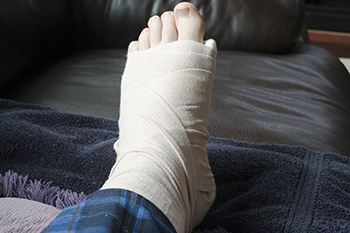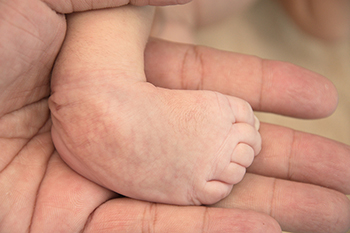Items filtered by date: May 2024
Pain and Foot Fractures

Foot fractures, though often underestimated, can cause significant pain and hinder mobility. A foot fracture occurs when one or more bones in the foot break, commonly due to trauma from falls, accidents, or repetitive stress from activities like running or jumping. Those at risk include athletes, individuals with osteoporosis, and people who have structural foot abnormalities. Diagnosing a foot fracture involves a physical examination, often accompanied by X-rays to confirm the extent and location of the injury. Symptoms typically include localized pain, swelling, bruising, and difficulty bearing weight on the affected foot. Pain, particularly while walking or bearing weight, is a hallmark symptom of a foot fracture. While some fractures may heal with rest and immobilization, others may require more aggressive treatment such as casting or surgery. If you believe you have sustained a foot fracture, it is suggested that you consult a podiatrist for a proper diagnosis and comprehensive plan to alleviate pain, promote healing, and prevent complications.
A broken foot requires immediate medical attention and treatment. If you need your feet checked, contact our podiatrists from CNY Foot Surgery & Podiatry Care. Our doctors can provide the care you need to keep you pain-free and on your feet.
Broken Foot Causes, Symptoms, and Treatment
A broken foot is caused by one of the bones in the foot typically breaking when bended, crushed, or stretched beyond its natural capabilities. Usually the location of the fracture indicates how the break occurred, whether it was through an object, fall, or any other type of injury.
Common Symptoms of Broken Feet:
- Bruising
- Pain
- Redness
- Swelling
- Blue in color
- Numbness
- Cold
- Misshapen
- Cuts
- Deformities
Those that suspect they have a broken foot shoot seek urgent medical attention where a medical professional could diagnose the severity.
Treatment for broken bones varies depending on the cause, severity and location. Some will require the use of splints, casts or crutches while others could even involve surgery to repair the broken bones. Personal care includes the use of ice and keeping the foot stabilized and elevated.
If you have any questions please feel free to contact our office located in East Syracuse, NY . We offer the newest diagnostic and treatment technologies for all your foot and ankle needs.
Managing Clubfoot

Clubfoot, a condition present at birth, can cause challenges as your child grows. Clubfoot is recognized by inward and downward foot placement, sometimes leading to differences in leg sizes. Clubfoot is typically diagnosed shortly after birth and affects about one in every 1,000 births, with boys affected more often than girls. This condition puts strain on the Achilles tendon, which connects the calf muscle to the heel. Treatment often involves gentle manipulation and therapy to help the foot develop normally. If left untreated, it can lead to difficulty walking and discomfort. Seeking early help from a podiatrist is important for managing clubfoot effectively and ensuring a healthier future for your child. In addition to Achilles tendon strain, other symptoms may arise, including pain, rigid leg movements, and difficulties with balance and sleep. Severe cases may require surgery, while milder cases can often be managed with braces and therapy. For help in managing clubfoot in your child, it is suggested that you schedule an appointment with a podiatrist.
Congenital foot problems require immediate attention to avoid future complications. If you have any concerns, contact our podiatrists of CNY Foot Surgery & Podiatry Care. Our doctors can provide the care you need to keep you pain-free and on your feet.
Congenital foot problems are deformities affecting the feet, toes, and/or ankles that children are born with. Some of these conditions have a genetic cause while others just happen. Some specific foot ailments that children may be born with include clubfeet, polydactyly/macrodactyly, and cleft foot. There are several other foot anomalies that can occur congenitally. What all of these conditions have in common is that a child may experience difficulty walking or performing everyday activities, as well as trouble finding footwear that fits their foot deformity. Some of these conditions are more serious than others. Consulting with a podiatrist as early as possible will help in properly diagnosing a child’s foot condition while getting the necessary treatment underway.
What are Causes of Congenital Foot Problem?
A congenital foot problem is one that happens to a child at birth. These conditions can be caused by a genetic predisposition, developmental or positional abnormalities during gestation, or with no known cause.
What are Symptoms of Congenital Foot Problems?
Symptoms vary by the congenital condition. Symptoms may consist of the following:
- Clubfoot, where tendons are shortened, bones are shaped differently, and the Achilles tendon is tight, causing the foot to point in and down. It is also possible for the soles of the feet to face each other.
- Polydactyly, which usually consists of a nubbin or small lump of tissue without a bone, a toe that is partially formed but has no joints, or an extra toe.
- Vertical talus, where the talus bone forms in the wrong position causing other bones in the foot to line up improperly, the front of the foot to point up, and the bottom of the foot to stiffen, with no arch, and to curve out.
- Tarsal coalition, when there is an abnormal connection of two or more bones in the foot leading to severe, rigid flatfoot.
- Cleft foot, where there are missing toes, a V-shaped cleft, and other anatomical differences.
- Macrodactyly, when the toes are abnormally large due to overgrowth of the underlying bone or soft tissue.
Treatment and Prevention
While there is nothing one can do to prevent congenital foot problems, raising awareness and receiving neonatal screenings are important. Early detection by taking your child to a podiatrist leads to the best outcome possible.
If you have any questions please feel free to contact our office located in East Syracuse, NY . We offer the newest diagnostic tools and technology to treat your foot and ankle needs.
Facts and Care Guidelines Regarding Diabetic Foot Ulcers

Diabetic foot ulcers, a common complication of diabetes, are open wounds that develop on the feet or lower legs, often due to poor circulation, nerve damage, or trauma. These ulcers can be slow to heal and prone to infection, posing serious risks if left untreated. Proper care is essential for managing diabetic foot ulcers and preventing complications. Begin by keeping the ulcer clean and dry, washing it gently with mild soap and water, and patting it dry with a clean towel. Apply an antibiotic ointment and cover the ulcer with a sterile dressing to protect it from further injury and reduce the risk of infection. Avoid putting weight on the affected foot and wear comfortable, well-fitted shoes to minimize pressure on the ulcer. Regularly monitor the ulcer for signs of infection, such as redness, swelling, or pus. If you are a diabetic and foot ulcers are a problem, it is strongly suggested that you are under the care of a podiatrist who can effectively treat these foot wounds and help you manage your diabetes.
Wound care is an important part in dealing with diabetes. If you have diabetes and a foot wound or would like more information about wound care for diabetics, consult with our podiatrists from CNY Foot Surgery & Podiatry Care. Our doctors will assess your condition and provide you with quality foot and ankle treatment.
What Is Wound Care?
Wound care is the practice of taking proper care of a wound. This can range from the smallest to the largest of wounds. While everyone can benefit from proper wound care, it is much more important for diabetics. Diabetics often suffer from poor blood circulation which causes wounds to heal much slower than they would in a non-diabetic.
What Is the Importance of Wound Care?
While it may not seem apparent with small ulcers on the foot, for diabetics, any size ulcer can become infected. Diabetics often also suffer from neuropathy, or nerve loss. This means they might not even feel when they have an ulcer on their foot. If the wound becomes severely infected, amputation may be necessary. Therefore, it is of the upmost importance to properly care for any and all foot wounds.
How to Care for Wounds
The best way to care for foot wounds is to prevent them. For diabetics, this means daily inspections of the feet for any signs of abnormalities or ulcers. It is also recommended to see a podiatrist several times a year for a foot inspection. If you do have an ulcer, run the wound under water to clear dirt from the wound; then apply antibiotic ointment to the wound and cover with a bandage. Bandages should be changed daily and keeping pressure off the wound is smart. It is advised to see a podiatrist, who can keep an eye on it.
If you have any questions, please feel free to contact our office located in East Syracuse, NY . We offer the newest diagnostic and treatment technologies for all your foot care needs.
It's Time for Beautiful Feet
Why Did I Develop a Heel Spur?

Heel spurs, bony protrusions that develop on the underside of the heel bone, can cause considerable pain and discomfort, making everyday activities such as walking or standing challenging. These spurs form in response to repeated strain or stress on the foot's ligaments and muscles, typically as a result of biomechanical issues or excessive pressure on the heel. Common contributing factors include wearing ill-fitting shoes, overuse during physical activities such as running or jumping, obesity, or having a flat or high arch. Additionally, age-related changes in foot structure and chronic conditions like plantar fasciitis or arthritis can increase the likelihood of heel spur development. While heel spurs may not always cause symptoms, they can exacerbate pain and inflammation in surrounding tissues, leading to discomfort and reduced mobility. A heel spur is treated by a podiatrist. If you have developed this condition, it is suggested that you consult this type of doctor who can accurately diagnose and treat heel spurs.
Heel spurs can be incredibly painful and sometimes may make you unable to participate in physical activities. To get medical care for your heel spurs, contact our podiatrists from CNY Foot Surgery & Podiatry Care. Our doctors will do everything possible to treat your condition.
Heels Spurs
Heel spurs are formed by calcium deposits on the back of the foot where the heel is. This can also be caused by small fragments of bone breaking off one section of the foot, attaching onto the back of the foot. Heel spurs can also be bone growth on the back of the foot and may grow in the direction of the arch of the foot.
Older individuals usually suffer from heel spurs and pain sometimes intensifies with age. One of the main condition's spurs are related to is plantar fasciitis.
Pain
The pain associated with spurs is often because of weight placed on the feet. When someone is walking, their entire weight is concentrated on the feet. Bone spurs then have the tendency to affect other bones and tissues around the foot. As the pain continues, the feet will become tender and sensitive over time.
Treatments
There are many ways to treat heel spurs. If one is suffering from heel spurs in conjunction with pain, there are several methods for healing. Medication, surgery, and herbal care are some options.
If you have any questions feel free to contact our office located in East Syracuse, NY . We offer the latest in diagnostic and treatment technology to meet your needs.




